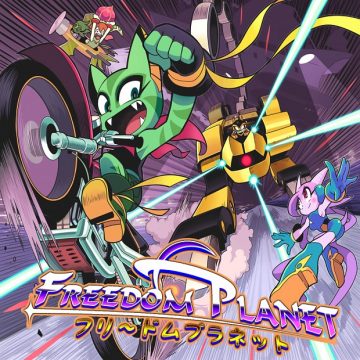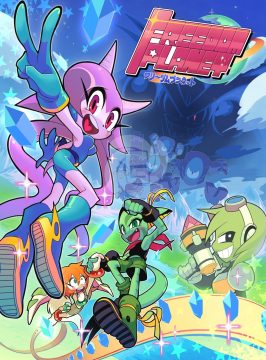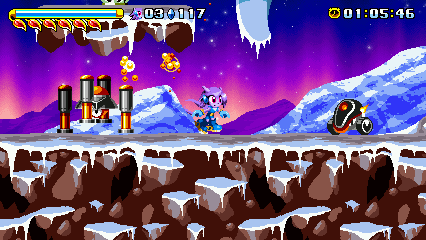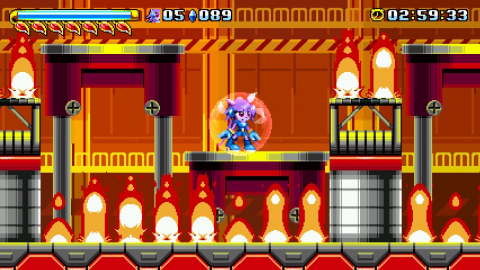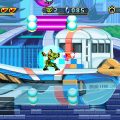- Freedom Planet
- Freedom Planet 2
Independent games tend to cover pretty much every sort of genre and inspiration one could possibly think of. Often, however, a lot of these games will take their ideas from the games of generations past, particularly where the NES is concerned. And that’s all well and good, but when it comes to retro stylings, it always seems like the 16-bit era and beyond has always been tragically ignored. They certainly exist, but you’re always more likely to find something that takes inspiration from games like Mega Man and Contra, as opposed to, say, Rocket Knight Adventures. Freedom Planet is definitely an exception to this rule, and a great homage to an era of gaming not often covered.
It’s almost impossible to talk about this game with at least some comparison to Sega’s Sonic the Hedgehog series. The game uses an engine that previously powered a number of Sonic fangames, and you’ve got brightly colored animals moving at high speeds through colorful levels, tearing their way through mechanical enemies. Not to mention elemental shields, loop-de-loops, springs, and a very familiar, yet uniquely terrifying timer when you’re about to drown. And to the developer’s credit, the influence has never been completely denied. But Sonic’s just one piece of a mixture that combines several classic action game of the 16-bit era into something that stands out on its own. So there’s definitely some Sonic in there, but you’ll also find a pinch of Ristar, some Mega Man X, a bit of inspiration from Rocket Knight Adventures, and even a little Gunstar Heroes, too.
The story takes place on the planet Avalice, where the evil alien Lord Brevon ends up crash landing after a space battle. He quickly overtakes the royal palace with the help of his troops, decapitates the king right in front of his own son, and brainwashes the prince. With the prince as his puppet, Brevon plans to start a war that will leave the planet in chaos, while snatching up the Kingdom Stone, the planet’s sole source of energy, to power his ship. Meanwhile, Lilac the water dragon and her friends are preparing for a trip to town, before a plane crash lands just ahead of them. What they end up discovering will lead them right into adventure, many confrontations with Brevon’s reptilian henchman Serpentine, and a whole lot of pandas trying to kill them.
Characters
Sash Lilac
The leader of the three main playable characters, Lilac is also the fastest character of the game. Her most useful ability is the Dragon Boost, which launches her quickly in any direction, Sparkster-style.
Carol Tea
Lilac’s best friend and apparently an ex-ninja, Carol isn’t quite as fast as Lilac, but she’s a little more agile. She gets a wall jump that lets her climb up sheer walls, along with a Chun Li-style kick that does heavy damage to enemies. She can also ride a motorbike by collecting gas cans you’ll find every so often. The motorbike vastly increases her speed and mobility, to the point she can ride up sheer walls, ceilings, and somehow, ladders.
Milla Basset
A young dog girl who hangs around with Lilac and Carol, Milla is the youngest and most untrained of the three. She’s also slower than the other two, and has the least health. The tradeoff is that she’s capable of manipulating energy for several useful effects, from reflecting projectiles to creating blocks she can toss at long range. She’s also the most annoyingly cute of all three playable characters, so keep that in mind before you choose her.
Lord Brevon
An alien warlord from a planet far away from Avalice, Brevon needs energy to repair his ship and resume his conquest of the universe. For the most part, he tends to stay in the shadows and manipulate the people around him to get things done for him. He’s also mutated most of the local wildlife to serve him. In a rather large departure from most platformer villians, he also carries a large machete with him. The moments when he appears are generally when the story gets its darkest.
The story is fairly complex for a platformer in this style, with a lot of cutscenes before and after each level. They’re all done in the game’s own engine, compete with full voice acting, which is a nice touch. Unfortunately, the story is far from the game’s best feature. There’s a lot of characters who enter the story who don’t really do much before they leave, and there are a few plot points that aren’t really well explained. There’s also a few scenes that, intentionally or otherwise, can be uncomfortable to watch. Without spoiling anything, Lord Brevon does quite a few things your average platformer villain probably wouldn’t. The effort put into the story definitely shows, but it’s a bit too rough around the edges to really enjoy. If you prefer to get right into the game, however, there’s a “Classic” mode that skips all the cutscenes entirely.
The three characters are differentiated very well, and each one’s different enough that you’ll get a different experience trying each of them out. They all get a variety of moves, with some, like Lilac’s divekick, working better for combat, while moves like Carol’s wall jump work better for exploration. Lilac and Carol also get a few special moves that do a lot of damage and give invincibility, handy for certain bosses. An energy meter limits how often you can use these, although it recharges automatically pretty quickly. Besides the difference they offer in gameplay, certain levels have routes that only a certain character can reach. And in a particularly cool touch, two of the characters get exclusive levels that make use of their special abilities.
While the game’s engine does have a certain feel that resembles the classic Sonic games, there are are a few subtle differences that give it its own feel. It’s a little tougher to reach full speed, and the physics are a little more forgiving. This is hardly a bad thing at all, however, since this gives you more control over your character, and makes precision platforming generally a lot easier. Every level has a pretty well balanced mix of pure speed, and slower, more platforming oriented sections, never moving too far in either direction. So while there’ll be a point where you’ll have to explore a level to find keycards to open doors, the game makes up for that when it makes you run from a wave of molten steel later on in the same level.
There’s also lot more emphasis on combat, which gives the game more of its own feel. The game uses a dedicated attack button, with each character getting a handful of moves to fight enemies off. Lilac has a rising uppercut and a divekick, as well as a pretty handy tornado attack, Carol gets a handy lightning kick that does a lot of damage quickly, while Milia can toss energy blocks from long range. The combat never actually gets annoying, however, since most enemies take a few hits to kill, or you’re free to ignore most enemies entirely. Most enemies can’t hurt you by touch alone, either, which reduces a lot of potential frustration. The tradeoff is that you’re dealing with a traditional life bar, represented by the cherry petals on your HUD, and you won’t often find extra health when you really need it.
A lot of the game’s Treasure inspiration comes from the sheer number of boss fights it has, with most levels having at least one mid-boss, with a much tougher final encounter at the end. Some of these put you up against your rivals, who are generally mobile enough that they can give you a lot of trouble. The real highlights, however, would be the huge, multi-sprited foes you’ll often come up against, most of them easily filling the screen. A lot of these bosses are where the difficulty picks up, as well, since some of the larger bosses can have their weak spots in spots that can be tricky to hit. They’re all generally pretty fun to fight, though, especially the missile-spewing panther mech you’ll encounter at the end of the third stage.
The levels are all pretty fun, too, and all of them have at least one thing that makes them unique or interesting. Most of the levels can stretch for quite a while, with the later levels taking around twenty or so minutes, if you’re not speedrunning them. They never end up getting dull, however, since most levels have two unique halves that introduce all sorts of new hazards and gimmicks. So while half of one stage will be set in the middle of a city, with trains to ride and slot machines to mess with, the other half will put you in a huge shopping mall, with an entirely new set of enemies and hazards to deal with. There’s also plenty of secrets and alternative routes, as well, which means there’s plenty of potential to just slow and down and explore.
While the first three or four stages of the game aren’t too rough, it’s after that point where the difficulty curve gets to be a little uneven. While there aren’t any points where the game gets especially unfair, some of the bosses can get to be pretty rough. Oddly enough, however, while the game uses a traditional lives system, you’ve got unlimited continues, with any continues you use taking you to your last checkpoint. On one hand, this essentially makes extra lives pointless unless you’re trying to complete the game on a single credit. It does, however, mean you’ll never have to redo a stage if you’re particularly bad at a certain section, which makes up for it. You’ll be especially thankful for this in the final stage, where the game sends out enemies so tough and platforming sections so harrowing, the game laughs at you when you die. It’s all worth it for an especially awesome, if difficult, final battle, however.
Once you finish the game, there’s still quite a bit of content left to do, as well. Even if you beat the game with all three characters, there’s a Time Trial mode that’ll let you challenge your best times, something which the game gives a lot of potential for. For people more into exploration, each level also has ten hidden cards, which, sadly, don’t do much aside from give out achievements and bragging rights. There’s also a bonus stage, Shang Mu Academy, which challenges you to make your way through an obstacle course, smashing a certain number of targets as quickly as possible. It’s not entirely unlike the Break the Targets stages from Super Smash Bros, and it’s a pretty fun little bonus.
The graphics are made up of some fantastic sprite work, with plenty of animation for the main characters. The levels are bright, colorful, and full of neat little touches. It also surpasses the bounds of what the Genesis was capable of, given how much smooth rotation the game uses, along with its higher color palette. The soundtrack is the same way, as while it’s clearly inspired by the music of great Genesis games before it, it brings more to mind the redbook soundtrack of an early Saturn game. While not all the tracks are amazing, there’s a few pretty good ones, particularly the boss tracks. The voice acting, while a little overdone at time, is pretty decent, and is charming, if you have nostalgia for the sorts of voices you’d get from companies like Working Designs.
For the work of a first time indie developer, Freedom Planet is a fantastic work, and a great homage to the often ignored 16-bit era of gaming. If you’re a fan of 16-bit action platformers at all, it’s worth looking past the game’s similarities and enjoying it as a fine game on its own. While the plot might be best ignored, and the difficulty can be somewhat suspect, it may well be one of the best 16-bit style retro platformers in a very long time.
During the Kickstarter campaign, two extra playable characters were promised as stretch goals. Unfortunately, these plans never really panned out. One new character, Torque, is only available for play in a handful of stages in the game’s time attack mode. The other promised character, Spade, never materialized at all. The developer has commented that he plans to place these characters into separate games of their own, but it remains to be seen if this will actually be the case.
Podcasts:
Game Club 199X: First Strike
Links:
Freedom Planet Official website for the game.

